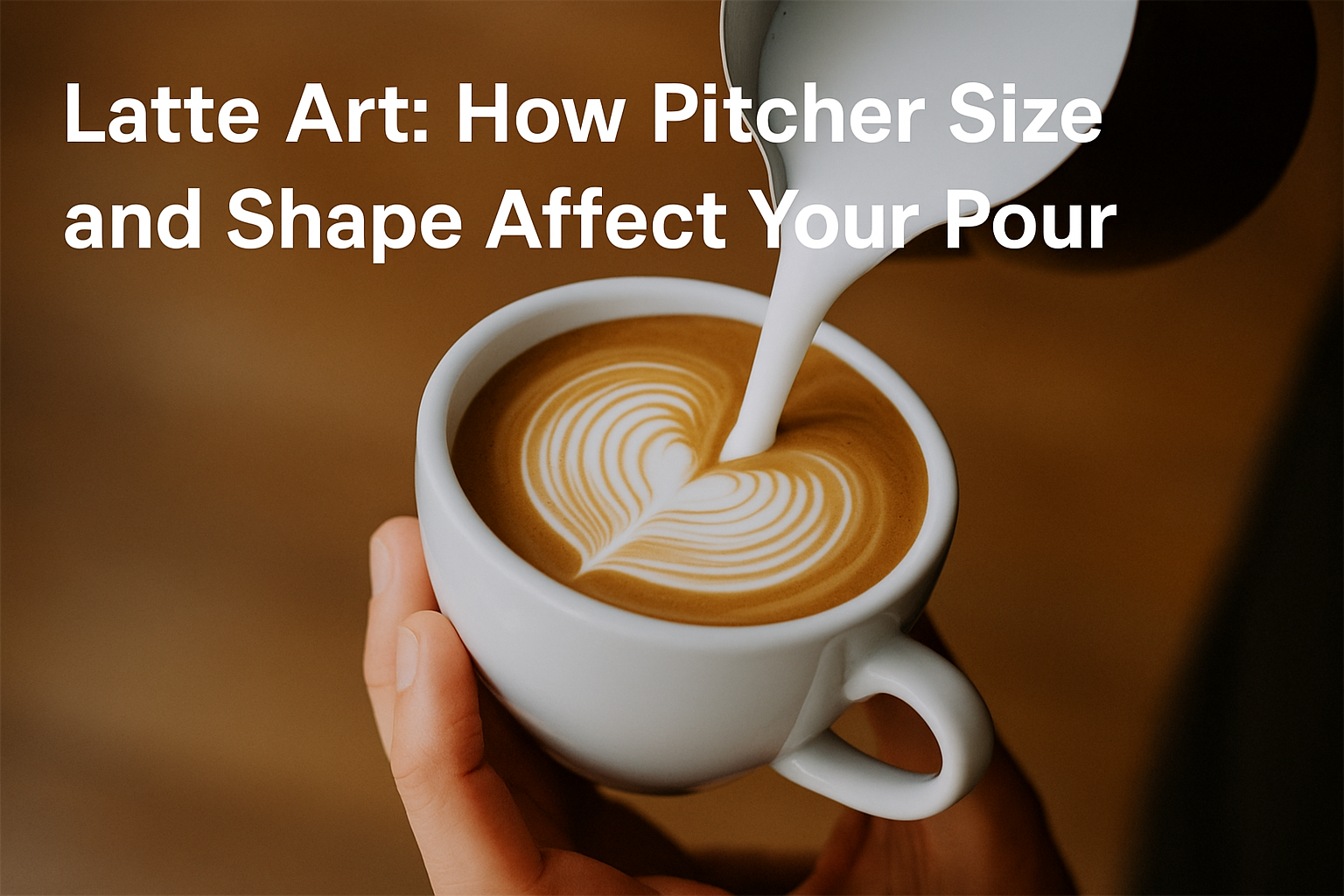When it comes to latte art, your milk pitcher is more than just a container — it’s a precision tool.
The size and shape of your pitcher directly influence your pour control, design accuracy, and consistency. If you’ve ever struggled with messy hearts or incomplete rosettas, your pitcher might be part of the problem.
Choosing the right pitcher and understanding how it works can significantly improve your latte art. In this guide, we’ll explore how different pitcher sizes, spout shapes, and handles affect the way milk flows and how designs form in the cup.
Whether you’re a beginner or refining your barista technique, mastering your pitcher is a key step toward more elegant, professional latte art.
Why the Right Pitcher Matters
The pitcher affects:
- How the milk flows during your pour
- How much control you have over the design
- The symmetry and detail of your latte art
- How easily you can transition between designs
An ideal pitcher gives you precision — so your heart looks like a heart, not a blob. It also helps you stay consistent during busy shifts, where quick, clean pours are essential.
Pitcher Size: Small, Medium, or Large?
Pitcher size is usually measured in ounces (oz) or milliliters (ml). Common sizes are:
- 12 oz (350 ml) – Best for small drinks (cappuccinos, flat whites, cortados)
- 20 oz (600 ml) – Ideal for larger drinks (lattes, mochas)
- 32 oz (950 ml) – Often used for multiple drinks or large milk batches
Small Pitchers (12 oz / 350 ml)
Best for:
- Learning to control flow
- Single cappuccinos or flat whites
- Tulips and hearts
Pros:
- More control due to compact size
- Less wasted milk
- Easier to manage pour height and speed
Cons:
- Limited capacity
- Not suitable for large drinks or two drinks at once
Medium Pitchers (20 oz / 600 ml)
Best for:
- Standard-size lattes
- Most café service needs
- Rosettas and more complex art
Pros:
- Versatile — good balance of control and volume
- Can handle a full latte or multiple small drinks
Cons:
- Slightly harder to control for beginners
- Wastes milk if underfilled
Large Pitchers (32 oz / 950 ml)
Best for:
- Steaming for two or more drinks
- Busy environments
Pros:
- High capacity
- Good for efficiency
Cons:
- Hard to control for precise pours
- Heavier and more awkward to handle
Spout Shape: Round, Sharp, or Custom?
The spout is the most important part of a pitcher for latte art. It controls how milk flows from the pitcher to the cup — affecting thickness, precision, and speed.
Rounded Spout
Features:
- Wide, curved opening
- Gentle, soft flow
Best for:
- Basic hearts and tulips
- Beginners
Pros:
- Easier to pour fast
- Smooth milk delivery
Cons:
- Less precision for detailed designs
- Harder to get sharp contrast
Sharp/Pointed Spout
Features:
- Tapered, narrow opening
- High control and precision
Best for:
- Rosettas, swans, detailed work
Pros:
- Clean lines
- Better contrast and sharpness
Cons:
- Requires better milk texture and control
- Not ideal for very thick milk
Custom or Hybrid Spouts
Some pitchers are designed with a mix of rounded and pointed characteristics, giving you a balance between smooth flow and detail control.
Best for:
- Baristas who do a mix of styles
- Intermediate to advanced users
Pitcher Handle and Body Shape
While often overlooked, the handle and body design of the pitcher can also impact comfort and control.
Handle Comfort
- Look for a sturdy handle that fits your hand size
- Some pitchers are handleless, designed for freestyle or competition use
- If the handle feels awkward or slippery, your control will suffer
Body Shape
- A tapered base helps whirlpool formation when steaming milk
- A straight body gives more even distribution and faster pouring
- Wider bodies can make it harder to control thin streams
Find what feels natural and stable in your hand — comfort equals confidence during the pour.
How to Choose the Right Pitcher for You
When selecting a pitcher, ask yourself:
- What drink sizes do I make most often?
- Do I prefer hearts and tulips, or detailed rosettas?
- Am I just learning, or am I doing high-level art?
- Do I need one pitcher for everything, or different ones for different tasks?
For beginners, a 12 oz pitcher with a rounded spout is a great starting point. As you progress, add a 20 oz pitcher with a sharp spout for more advanced designs.
Professional baristas often have multiple pitchers, each for a specific purpose.
How Pitcher Technique Affects Your Pour
Even with the perfect pitcher, how you hold and use it matters. Key technique elements include:
- Pour height – Start high to integrate milk, drop low for design control
- Pour speed – Slow pour = more control, fast pour = broader designs
- Tilt angle – Adjusting the cup or pitcher angle changes flow rate
- Wrist vs arm – Use your wrist for subtle movement and better control
A good pitcher supports your technique — it doesn’t replace it.
Tips for Practicing With Different Pitchers
- Try the same pour with two different pitchers and observe differences
- Film yourself to evaluate grip, angle, and flow
- Switch between small and medium sizes to adapt your control
- Practice specific designs (e.g., rosettas) with sharp spouts only
- Use dish soap and water for low-cost training without milk waste
The more you experiment, the more you’ll understand how pitcher dynamics affect your art.
Final Thoughts: Your Pitcher Is Your Brush
Latte art is like painting, and your milk pitcher is your brush. The size, shape, and design of that brush can either enhance or limit your ability to express yourself in the cup.
As a barista, don’t settle for a one-size-fits-all approach. Understand your tools. Invest in pitchers that match your skill level and your goals. Most importantly, practice intentionally — the right pitcher won’t make you an artist overnight, but it will give you the control you need to become one.

Marcelo Rodrigues is a passionate barista with over 7 years of experience in specialty coffee. He’s worked in top cafés, led barista training sessions, and now shares practical tips to help beginners and coffee lovers improve their skills. Through this blog, Marcel makes the world of coffee more accessible—one cup at a time.

